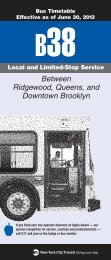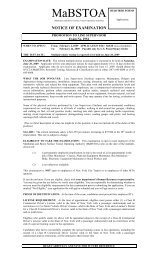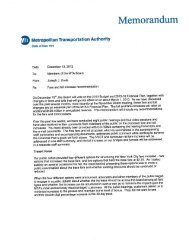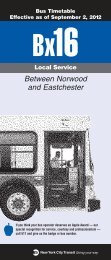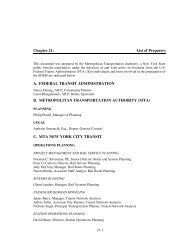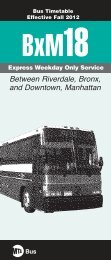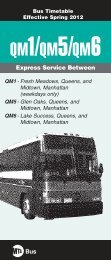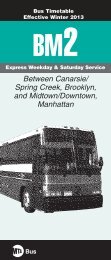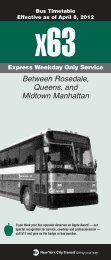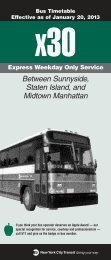Greening Mass Transit & Metro Regions: The Final Report - MTA
Greening Mass Transit & Metro Regions: The Final Report - MTA
Greening Mass Transit & Metro Regions: The Final Report - MTA
You also want an ePaper? Increase the reach of your titles
YUMPU automatically turns print PDFs into web optimized ePapers that Google loves.
2. Authorize the next federal transportation bill at $1 trillion for 2010-2015.<br />
• Create a robust state-of-good-repair program. Target the rehabilitation and preservation of existing infrastructure<br />
investments in areas where the environmental and economic benefits are the greatest.<br />
• Reform the way in which funds are distributed. Move away from formulas and categories toward objectives and<br />
outcomes. Prioritize funding for green climate mitigation and adaptation projects in smart-growth locations in metropolitan<br />
areas in order to achieve environmental, economic, and equity goals.<br />
• Develop performance measures that recognize existing conditions. <strong>Transit</strong> investments in densely developed areas with<br />
a high transit-mode share serve to maintain existing densities and ensure riders do not divert to auto use. Measures must<br />
account for projects in these areas as well as projects aimed at attracting new riders and/or development.<br />
• Incentivize regional coordination, intermodal projects, and pricing. Provide incentives for the planning and development of<br />
regional transportation services which connect multiple jurisdictions and systems. Encourage pricing strategies to generate<br />
revenues and manage demand.<br />
• Streamline federal processes and procedures. Guarantee that authorized funds are appropriated annually by October 1<br />
and then received in a timely manner through enforceable timelines for grant review.<br />
• Require transit agencies seeking federal funds to commit to a baseline of green standards. <strong>The</strong> American Public Transportation<br />
Association (APTA) should work with the <strong>MTA</strong> and other transit agencies to develop these minimum standards.<br />
3. Pass a federal version of California’s SB 375, which links efficient land use with transportation infrastructure<br />
investment in order to reduce GHG emissions.<br />
A federal version of this bill would: (1) establish GHG reduction targets for metropolitan areas; (2) require regions to develop<br />
a land-use pattern and a transportation network that achieve the necessary reductions in emissions from cars and light<br />
trucks; and (3) provide federal infrastructure funding as an incentive for metropolitan areas to implement the regional plans.<br />
<strong>The</strong> bill should take into account conditions in New York City of existing high density and existing high transit mode share.<br />
4. Provide leadership and funding for climate adaptation.<br />
Establish a lead federal agency to coordinate federal, state, and local efforts and funding for climate adaptation plans,<br />
programs, and strategies.<br />
5. Increase the monthly commuter tax benefit to $230 per month for commuters using transit and index both the<br />
transit and parking benefits to inflation.<br />
Increasing the allowable tax-free amount to $230 per month for transit commuters will create equity between transit and<br />
commuter parking pre-tax benefits. This increase will provide a greater incentive for employers to offer pre-tax commuter<br />
benefits and for more employees to utilize these programs. <strong>The</strong> <strong>MTA</strong> will benefit by increasing revenues and lowering the<br />
costs associated with cash handling and individual fare transactions. <strong>The</strong> region’s employers also benefit through additional<br />
payroll tax savings.<br />
6. Provide incentives to lenders and financial institutions that offer Location-Efficient Mortgages (LEMs).<br />
LEMs use available transportation-related savings and flexible qualifying ratios to add thousands of dollars of home buying<br />
power to the budgets of people looking for homes well-served by transit—in what have been called “location efficient”<br />
communities. If homebuyers purchase homes in areas that are well served by transit, they are assumed to be saving money<br />
by foregoing auto expenses. This money is counted as income, thus allowing them to qualify for a mortgage and buy<br />
housing closer to transit. LEMs can be structured in various ways including lower interest rates or better debt-to-equity<br />
ratios and better down-payment terms.<br />
By increasing housing opportunities in location-efficient communities, LEMs achieve three main environmental goals: (1)<br />
they reduce fuel consumption; (2) they decrease the demand for sprawling developments and new road infrastructure; and<br />
(3) they lower pollution from automobiles. Additionally, LEMs are an excellent opportunity to make affordable housing<br />
available to more people.<br />
65



